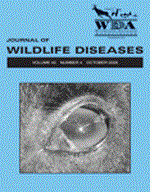Between 2 August and 22 September 2000, 37 hunter-killed tule elk (Cervus elaphus nannodes) were evaluated at the Grizzly Island Wildlife Area, California, USA, for evidence of paratuberculosis. Elk were examined post-mortem, and tissue and fecal samples were submitted for radiometric mycobacterial culture. Acid-fast isolates were identified by a multiplex polymerase chain reaction (PCR) that discriminates among members of the Mycobacterium avium complex (MAC). Histopathologic evaluations were completed, and animals were tested for antibodies using a Johne's enzyme–linked immunosorbent assay (ELISA) and agar gel immunodiffusion. In addition, 104 fecal samples from tule elk remaining in the herd were collected from the ground and submitted for radiometric mycobacterial culture. No gross lesions were detected in any of the hunter-killed animals. Mycobacterium avium subsp. paratuberculosis (MAP) was cultured once from ileocecal tissue of one adult elk and was determined to be a strain (A18) found commonly in infected cattle. One or more isolates of Mycobacterium avium subsp. avium (MAA) were isolated from tissues of five additional adult elk. Gastrointestinal tract and lymph node tissues from 17 of the 37 elk (46%) examined had histopathologic lesions commonly seen with mycobacterial infection; however, acid-fast bacteria were not observed. All MAC infections were detected from adult elk (P = 0.023). In adult elk, a statistically significant association was found between MAA infection and ELISA sample-to-positive ratio (S/P)≥0.25 (P=0.021); four of five MAA culture–positive elk tested positive by ELISA. Sensitivity and specificity of ELISA S/P≥0.25 for detection of MAA in adult elk were 50% and 93%, respectively. No significant associations were found between MAC infection and sex or histopathologic lesions. Bacteriologic culture confirmed infection with MAP and MAA in this asymptomatic tule elk herd. The Johne's ELISA was useful in signaling mycobacterial infection on a population basis but could not discriminate between MAA and MAP antibodies. The multiplex PCR was useful in discriminating among the closely related species belonging to MAC.
How to translate text using browser tools
1 October 2006
MYCOBACTERIUM AVIUM SUBSPECIES PARATUBERCULOSIS AND MYCOBACTERIUM AVIUM SUBSP. AVIUM INFECTIONS IN A TULE ELK (CERVUS ELAPHUS NANNODES) HERD
Graham C. Crawford,
Michael H. Ziccardi,
Ben J. Gonzales,
Leslie M. Woods,
Jon K. Fischer,
Elizabeth J. B. Manning,
Jonna A. K. Mazet

Journal of Wildlife Diseases
Vol. 42 • No. 4
October 2006
Vol. 42 • No. 4
October 2006
Cervus elaphus nannodes
ELISA
Grizzly Island Wildlife Area
IS900
Johne's disease
Mycobacterium avium ss. avium
Mycobacterium avium ss. paratuberculosis




